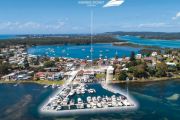
Preparation is key to countering Amazon threat
The imminent arrival of Amazon in Australia next year could be devastating for domestic retailers if they don’t prepare in advance for the US juggernaut’s arrival, a leading retail expert has warned.
“Between 2010 and 2016, Amazon quadrupled its sales in North America from $US16 billion ($21.4 billion) to $US80 billion,” says Colliers International national director of retail Michael Bate. “That’s unbelievable.
“That’s like growing by three of the retail giant Sears in six years. That’s enormous. It’s difficult to comprehend.”
CSIRO Data61 chief executive Adrian Turner similarly brands Amazon’s entry into Australia to sell everything from electronics to e-books, fashion to food – with a possible delivery time of as little as one hour – a “life-threatening wake-up call”. He predicts that its effect on retailers could be devastating, with only 14 per cent of domestic businesses who realise it’s setting up here having a plan in place to compete.
“Today more than 50 cents of every dollar spent online in the US is spent with Amazon,” Turner says. “Their online customer acquisition and conversation ratios are almost five times higher than our online retailers.”
But not everyone has been enveloped by the prevailing retailer mood of fear and loathing. Mirvac head of retail Susan MacDonald has studied Amazon for years, particularly when she worked in the United States and Britain.
As a result, she has already put plans in place to make sure the company’s 16 shopping centres in Sydney, Melbourne and Brisbane are able to compete, in terms of helping their tenants and keeping their customers, when Amazon does set up on our shores, selling 10 centres and investing hugely instead in those in select locations.
“We are always wary about competition and don’t have anything like the same level of investment in research and development,” MacDonald says. “But at the same time, we’ve seen in the US and UK and certain Asian markets that strong and agile retailers will still survive and flourish, although carrying less stock and encouraging strong pedestrian flows.”
Research at the nation’s shopping centres has shown that most customers, surprisingly, don’t say their primary motivation for going shopping is … actually shopping. Most says it’s more about getting out of the house and entertaining the kids. People love the public space they offer, often the free Wi-Fi available in those zones and power points, and like to relax in those spaces, work or study. Once, they might have gone to a park; today they prefer the controlled, pleasant and well-lit environments of shopping centres.
“People see shopping centres as a third workplace, away from home and the office,” MacDonald says. “They love the amenity and the fact they’re open to everyone. A lot more people live in apartments today and they like to get out and shopping centres are inviting, like beaches and parks.
“So there’s definitely a future for retail, and we just need to invest in their amenity and in the customer experience.”
Many commentators have forecast that Australia’s bigger stores – such as the currently struggling Myer, Harvey Norman and JB Hi-Fi – will be affected the most. Amazon already has a firm toehold in the domestic market, with Morgan Stanley analysts saying sales worth $1 billion are being shipped here annually by the company from overseas.
Asset managers UBS conducted a survey of brokers and fund managers in April and found that they believed Amazon’s foray into Australia would cut discretionary retailers’ earnings by 16 per cent, and grocery companies’ profits by 12 per cent.
“Hype surrounding Amazon’s entry into Australia is high, and share prices have reacted accordingly,” says UBS retail analyst Ben Gilbert says. “The responses around whether the market was overreacting to the Amazon impact were mixed. On balance, the view was the market had somewhat over-reacted.”
But the fightback has already begun from some retailers to shore up business in advance. Property group Stockland, with a strong portfolio of shopping centres, has been investing heavily in those centres it feels have a good future, and adding food and beverage outlets at all of them.
In East Maitland, north of Sydney, it’s just completed stage one of the $412 million redevelopment and expansion of Stockland Green Hills Shopping Centre; in Bundaberg, Queensland, it opened the $30 million Stockland Kensington Shopping Centre.
Stockland managing director and CEO Mark Steinert says that, despite a relatively flat quarter, the company is moving forward. “We’ve continued to invest in our portfolio and remix the centres to deliver good growth of 2.7 per cent in speciality sales per square metre across our comparable shopping centre portfolio,” he says.
Michael Bate believes electronics companies will be hit hard, as well as our big online sellers such as The Iconic, Red Balloon and Temple & Webster. But bricks and mortar, largely, will survive, he predicts.
“There’s still this underlying desire by Australian consumers to touch and feel and try products, and also eat and drink in the 180 shopping centres around the country,” he says. “And when Amazon will bring in their food arm, Fresh, they’ll be competing against three of our most successful brands: Woolworths, Coles and Aldi.
“The other thing is that you can go into a store and haggle over a price, like white goods at Harvey Norman or Bing Lee. You can even do that at JB Hi-Fi. But you can’t ever do that online.”
Where companies have invested wisely in shopping centres – like the Westfield Warringah Mall, downsizing Myer, bringing in quality global brands and adding good food and beverage offerings – they should rebuff the competition extremely effectively, Bate believes. Similarly, those centres that have increased their entertainment quotient, like great new cinemas at Green Hills, and rooftop and outdoor dining, will be shored up.
“It’s about offering the best service, a great mix of stores and services, and elements like childcare,” he says. “That’s the way to beat Amazon.”












